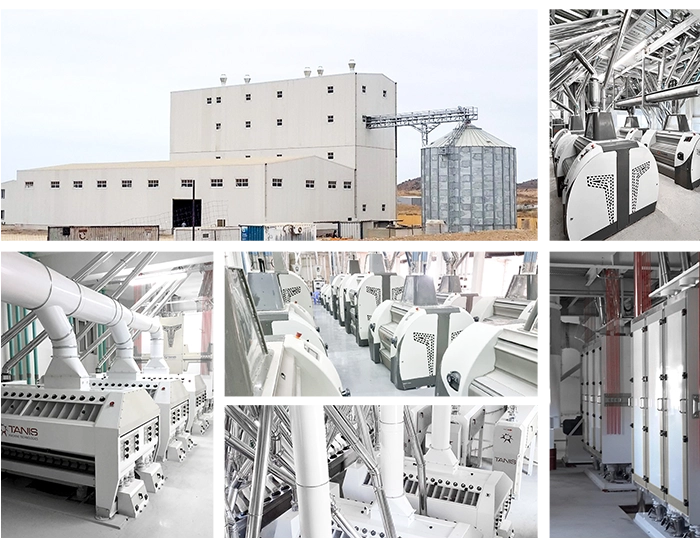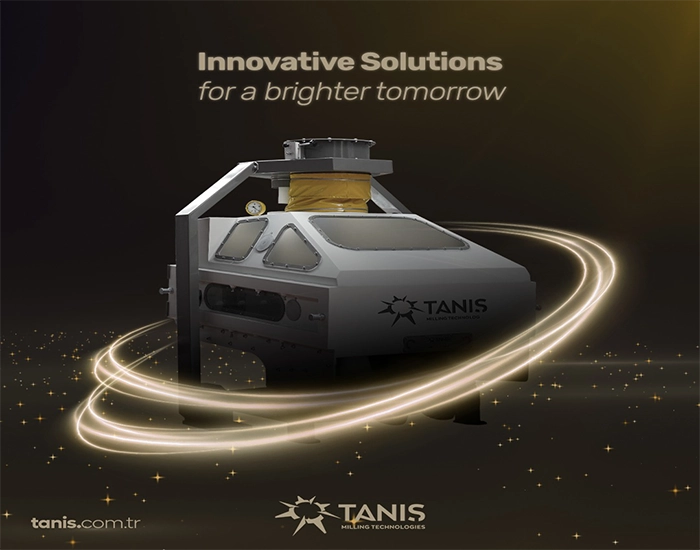Developing successful strategies in the mill sector and ensuring sustainable growth is possible through access to comprehensive and up-to-date data. Accurate and timely research reports play a critical role in businesses’ strategic decisions, strengthen risk management, and guide investment plans. As Tanış A.Ş., with over 60 years of industry experience, we embrace a data-driven approach, providing in-depth industry research and market analysis to support our customers’ informed decision-making.
Global Equipment Market Analysis
The global mill equipment market was valued at $12.5 billion as of 2024, showing an average compound annual growth rate (CAGR) of 5.8% over the past 5 years. The market shows regional distribution as follows: Asia-Pacific (42%), Europe (28%), North America (15%), Middle East and Africa (10%), and Latin America (5%).
When examining producer countries, Germany, Italy, Switzerland, Turkey, and China are leading. In the sector, companies such as Bühler Group (Switzerland), Ocrim (Italy), IMAS (Turkey), and Alapala (Turkey) hold significant global market shares.
Turkey Sector Data
Turkey’s mill equipment sector has a strategic position in the global market with a market size of $1.2 billion. The machinery park in the country includes approximately 450 manufacturing companies, with annual production capacity reaching $600 million. The domestic market has shown an average annual growth of 3.5% over the past three years.
When examining the competitive environment in Turkey, 10 large companies control approximately 65% of the market, while the remaining 35% is distributed among medium and small-scale companies. Export-oriented companies particularly gain significant advantages in global competition through innovative technologies and quality standards.
Global mill equipment production capacity is at an annual level of $15 billion, with capacity utilization rate averaging 83%. In Turkey, the sector’s production capacity utilization rate is around 75%, while this rate reaches 85% in export-oriented companies.
Analyses regarding production efficiency show that productivity increases of up to 30% occur in businesses that transition to fully automatic production systems. Robotic applications and smart production systems stand out as key technological investments that increase production efficiency.
Equipment Export and Import Data
Global mill equipment trade volume is at an annual level of $8.5 billion. Turkey ranks among the leading exporting countries in the sector with an annual export performance of $750 million. In Turkish manufacturers’ exports, Middle East and Africa countries have a 45% share, CIS countries 25%, Europe 15%, Asia 10%, and America 5%.
When examining the export-import balance, Turkey provides a foreign trade surplus of $700 million in the mill equipment sector. Complete turnkey projects and integrated solutions particularly stand out as high value-added areas in exports.
Production Cost Analysis
The cost distribution in mill equipment production is: raw materials and supplies (55-60%), labor (15-20%), energy (5-8%), R&D (3-6%), and other operational expenses (10-15%). The increase in steel and electronic component prices over the past three years has caused an average 18% rise in production costs.
Prominent strategies for optimizing costs include supplier diversification, use of advanced planning systems, energy efficiency investments, and automation-based labor optimization. Cost optimization of 12-15% is achieved in businesses using advanced data analytics.
Investment and Return Analysis
Modern mill facility setup investment ranges from $5-30 million depending on capacity. Investment return periods are calculated as 6-8 years in developed markets and 4-6 years in developing markets. Among financing options, investment incentives, export credits, and green financing models stand out.
Economic analysis of modernization investments shows that existing systems provide 30-50% efficiency improvement and generally amortize within 2-4 years. Modernization projects focused on digitalization and energy efficiency particularly stand out as investment areas providing the fastest returns.
Global Production and Consumption Data
Global grain production occurs at an annual average level of 2.8 billion tons, with approximately 780 million tons consisting of wheat. Major producer countries include China, India, Russia, USA, and EU countries. Production trends have shown an average annual growth of 1.6% over the past five years.
When examining consumption trends, per capita grain consumption in developing countries shows an annual increase of 2.2%, while in developed countries there is a declining trend of 0.8% with a shift toward alternative protein sources. Global stock levels have been found to decrease by 5.7% over the past two years.
The mill products market has reached a global size of $450 billion, showing 3.2% annual growth. Changes in consumption habits occur particularly in the form of increased demand for whole grain products and the prominence of functional flour products.
When examining demographic factors, it is observed that basic flour product consumption remains high in countries with young populations, while health-focused specialty flour products grow faster in markets with aging populations. This situation increases the importance of diversity and flexibility in mill technologies.
Technology and Innovation Research Findings
Digitalization Research
The digitalization and automation adaptation rate in the mill sector is 78% in developed countries and 42% in developing countries. Industry 4.0 applications’ penetration in the sector has increased by 55% over the past three years. Return analyses of digital transformation investments show amortization in an average of 3.2 years through productivity increases, energy savings, and labor optimization.
Technology adaptation statistics reveal that cloud-based control systems increased by 120%, IoT applications by 85%, and AI-supported quality control systems by 65%. Businesses that adopt these technologies early observe competitive advantage and market share growth.
Energy consumption in the mill sector constitutes 15-20% of total operational costs. Modern energy-efficient systems have been found to consume 35-40% less energy compared to conventional systems. The prevalence level of green production practices in the sector is 65% in developed markets and 30% in developing markets.
When analyzing the economic impacts of sustainability investments, energy efficiency projects amortize within 2-4 years, renewable energy investments within 5-7 years, and waste management systems within 3-5 years. Investments made in line with carbon footprint reduction goals provide competitive advantage especially in the European market.
Regional Sector Research
Europe Sector Analysis
The European mill equipment market is $3.5 billion in size, and sector players are observed to follow high-technology and sustainability-focused strategies. Technology adaptation level is 85%, above the global average, while digital twin and artificial intelligence applications are rapidly spreading.
Regulatory developments are progressing particularly in the direction of carbon emission limitations and energy efficiency standards within the scope of the Green Deal. This situation directs companies operating in the European market toward investments in sustainable technologies.
The Middle East and Africa region is the fastest-growing mill equipment market with a market size of $2.1 billion and an annual growth rate of 7.5%. The capacity utilization rate in the region is 65%, below the global average, offering significant opportunities for modernization and capacity expansion investments.
When analyzing technology needs, energy-efficient systems, complete automation solutions, and integrated quality control systems stand out. The competitive environment, while being price-focused, is evolving into a structure where value-added services such as after-sales services and financial solutions gain importance.
Tanış A.Ş. Sector Research Services
Customized Research Reports and Analysis
As Tanış A.Ş., we provide customized research reports and market analysis for our customers’ specific needs. Our competitive analysis, market opportunity assessment, target market analysis, and strategic positioning studies support your data-based decision-making processes.
We contribute to your international growth goals by preparing comprehensive reports on identifying markets with high export potential, country risk assessment, and market entry strategy development. Our investment feasibility and return analysis services strengthen your financial planning.

Sectoral Benchmarking and Performance Evaluations
Our benchmarking analyses that compare your business’s operational performance with sector leaders help you identify development areas and increase your competitive strength. We offer comparison opportunities in critical indicators such as energy consumption, efficiency, quality performance, and cost structure.
Our technology level assessment service provides technological adequacy analysis of your existing machinery park, supporting you in determining your modernization and investment priorities. Our competitive strength analysis and cost optimization reports add a data-driven perspective to your strategic decisions.
Regular Sector Reports and Bulletins
Our sector evaluation reports published monthly and quarterly provide current information about market dynamics, competitive developments, and technology trends. Our price and cost trend reports analyze changes in raw material and equipment prices, guiding your budget planning.
Our technology and innovation bulletins enable you to follow the latest technological developments, patent trends, and innovative applications in the sector. You can have regular access to this valuable content by subscribing to our free e-bulletin.

Frequently Asked Questions
Africa and South Asia regions are the fastest-developing mill equipment markets with annual growth rates of 7.5% and 6.8% respectively. Increasing population, urbanization, and food processing needs in these regions are the main driving forces of sector growth.
The global penetration rate of fully automatic mill facilities is at 38%, with this rate reaching 65% in developed markets. In facilities with high automation levels, productivity increases by 30-40% and labor cost savings by 50-60%.
The return period for a modern mill facility investment varies according to market and business scale, but is calculated in the range of 6-8 years in developed markets and 4-6 years in developing markets. Productivity increase, quality improvement, and energy savings are the main factors that accelerate investment returns.
